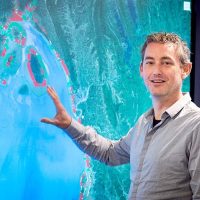Mapping the development of the Sand Motor down to the grain
The coast is constantly in motion due to currents, waves and wind. But how do sand grains move as they travel along the coast? The SedTRAILS model, developed by Deltares and Delft University of Technology, converts the results of traditional coastal models into individual sediment pathways. We're using this new approach to map sediment pathways: routes that grains of sand travel.

Mapping sand paths
At a time when the pressure on our coastal areas is increasing due to climate change, rising sea levels and a growing population, it is important to know how our coasts will respond. The SedTRAILS model, developed by Deltares and Delft University of Technology, converts the results of traditional coastal models into individual sediment pathways. This method allows us to visualise the hidden routes that sand takes, giving us a better understanding of how dynamic processes shape our coast. Instead of only being able to rely on seabed changes, we can now follow the sand from source to sink.
Application to Sand Motor
The SedTRAILS model has been applied to the Sand Motor, a Nature-Based Solution that can be described as a mega-nourishment, an artificial peninsula that protects us from rising sea levels, which was constructed in 2011 off the Delfland coast near Kijkduin.
Years of 'traditional' monitoring and modelling studies show that the Sand Motor is spreading as originally intended: while the peninsula is eroding at the tip, the adjacent beaches are growing. But this does not tell the whole story. Where does the sand that makes these beaches grow come from? Does it originate directly from the Sand Motor or are there other sources? And how far does the nourished sand reach?
New insights can be valuable for understanding the development of Nature-based Solutions for our coastal defence such as the Sand Motor, and thus the decision-making about its management. The technique allows for a more efficient tracking of the Sand Motor's development, enabling quicker assessment of its impacts. As a result, it facilitates the evaluation of how to strengthen and protect the surrounding coastal areas.
Dynamic coast
To answer above mentioned questions, it is necessary to follow the journey of sand, both underwater and on the beach. This presents challenges, especially with a dynamic coast like the Sand Motor, where grains of sand are buried or released by changes in the seabed.
For the first time, we've been able to outline sediment pathways that take the dynamics of the coast into consideration. We do so by adapting the existing SedTRAILS method and taking changes in the seabed into account.
The improvements to the approach now make it possible to apply the method of mapping sediment pathways along the coast over much longer periods than what was previously possible: from years to decades instead of weeks to months.
Animation
Sediment particles move across the Sand Engine — white for natural sand, purple for nourished sand — as waves, wind, and tides reshape the coastline. The colors show the beach and seabed level over time. As the Sand Engine evolves, particles are buried by deposition or exposed by erosion. Buried particles disappear from view in this animation.
You have not yet indicated whether you want to accept or reject cookies. This means that this element cannot be displayed.
Or go directly to:
Implications for coastal management
The sediment pathways outlined provide answers to the questions posed earlier. The simulations show that the majority of the sand nourished at the Sand Motor moves northwards, but that the net distance travelled is greatly limited by seabed changes; the growing beach buries grains of sand relatively quickly. As the Sand Motor develops, these changes diminish, allowing the sand to spread further before it is deposited. The simulations showed that less than one percent of the sand moved at least 2.5 kilometres in the first year, while this percentage had risen to 21 percent by the fourth year.
It is also possible to trace grains of sand that have washed up on the surrounding beaches back to their origin. The results show that these washed up grains do not only come from the Sand Motor itself, but on the south side are a mix of nourished sand and sand from sources further upstream.
Future development of SedTRAILS
This research was realised in collaboration with TU Delft (Matthieu de Schipper and Stuart Pearson). A new version of SedTRAILS will be developed in 2025 to make the model more accessible for development and application within projects and further research. Deltares and TU Delft will collaborate on this, with support from the TU Delft Digital Competence Center (DCC).
For more information about the method and the results, please refer to this research article in Nature: 'Lagrangian modelling reveals sediment pathways at evolving coasts'.




